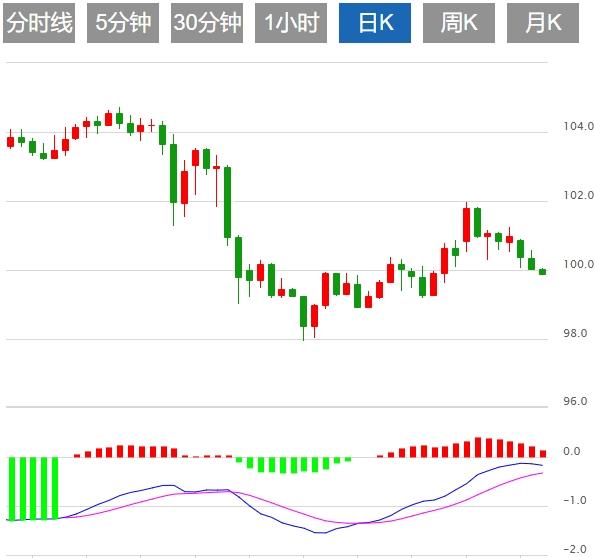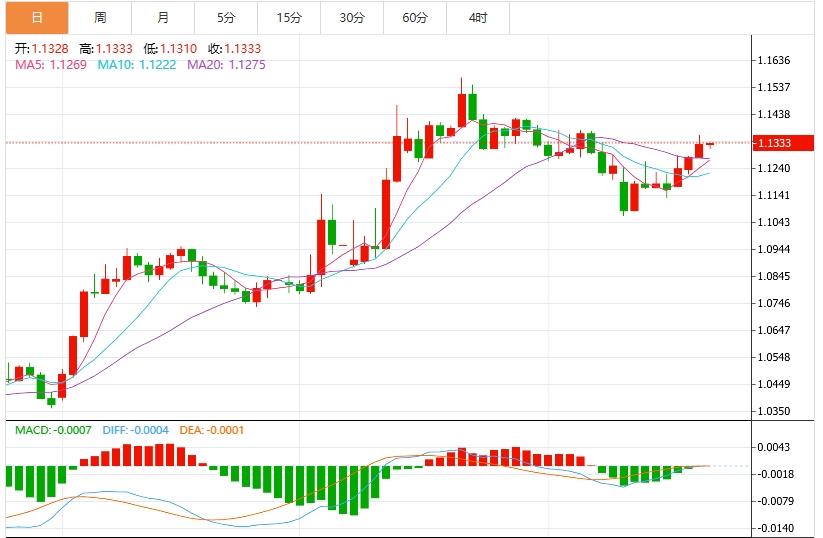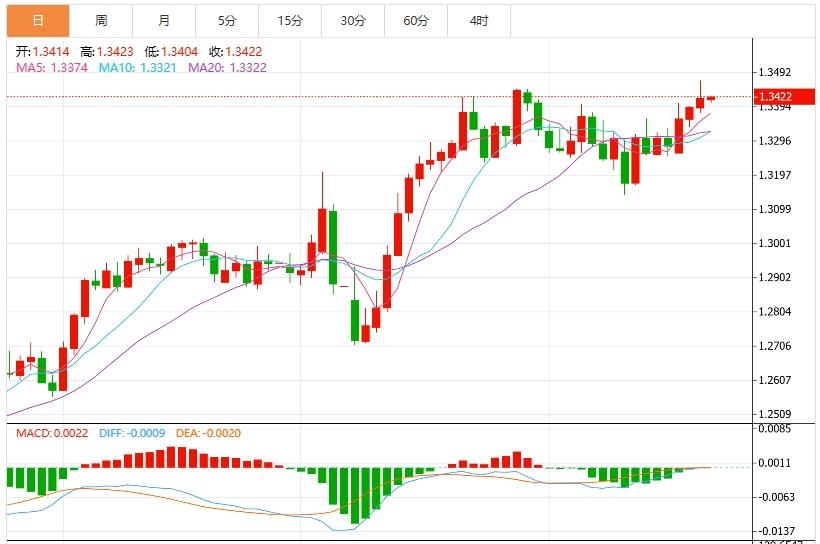Trusted by over 15 Million Traders
The Most Awarded Broker
for a Reason
market analysis
The US dollar index fluctuates downward, European and American PMI data is coming
Wonderful introduction:
Optimism is the line of egrets that are straight up to the blue sky, optimism is the ten thousand white sails beside the sunken boat, optimism is the lush grass that blows with the wind on the head of the parrot island, optimism is the falling red spots that turn into spring mud to protect the flowers.
Hello everyone, today XM Foreign Exchange will bring you "[XM Group]: The US dollar index fluctuates and goes down, and European and American PMI data is zeizao.cning." Hope it will be helpful to you! The original content is as follows:
On Thursday, the US dollar index fell slightly, and the US dollar index performed weakly recently, falling 0.6% on Wednesday, losing the 100 integer mark, and the intraday low hit a new low of 99.33 in the past two weeks. Current market sentiment shows obvious characteristics of caution. On the one hand, geopolitical risks continue to ferment, especially the uncertainty of the situation in the Middle East has exacerbated the market's risk aversion; on the other hand, the domestic political deadlock in the United States and the uncertainty of the tax reform bill have further increased market volatility. This trading day will be released on PMI data in European and American countries in May, changes in the number of initial unemployment claims in the United States, and the total annualized number of existing home sales in April. Investors need to pay attention to it. In addition, we will continue to pay attention to the international trade situation, geopolitical situation and news related to the G7 meeting, and pay attention to the speeches of Federal Reserve officials.
Analysis of major currencies
United States dollar: As of press time, the US dollar index hovered around 99.48, down 0.11% during the day. Since the beginning of this week, the dollar has paid the price for the volatility of Trump's administration's policies, which is currently facing difficulties in many aspects. Hawkish rhetoric by Fed officials has significantly lowered market expectations for a recent rate cut, which provides support from the dollar to some extent. However, the ongoing political uncertainty and geopolitical risks put pressure on the US dollar, forming a delicate balance. It can be observed from the daily chart of the US dollar index that the price is in a key technical position. After experiencing a sharp decline in the previous period, DXY has now gained some support near the 99.20 area. Previously, the index hit a low of 97.9229 and then launched a rebound, but recently fell back under pressure. In terms of MACD indicators, the DIFF line is -0.2228 and the DEA lineAt -0.3051, the MACD value is 0.1644, the bar chart is red, but the cylinder height is shrinking, which may indicate that the kinetic energy is weakening.



1. The weak 20-year U.S. bonds and foreign exchange fell, and the value of US bonds and foreign exchange fell. After the results of weak demand for US 20-year U.S. Treasury bonds and foreign exchange fell one after another. Deutsche Bank analyst George Saravelos sees the market's reaction as a clear signal of "foreign buyers collectively avoiding U.S. bond assets." He noted that foreign investors "are no longer willing to fund the U.S. government at current prices." The rise in financing costs is putting pressure on the stock market. Unless there is a major adjustment in the fiscal settlement bill proposed by the Republican Party, the value of U.S. bonds will have to "sharply decline" to re-attract foreign investors. Affected by this, the S&P 500 index's decline expanded to 1.5% in the day, and the 10-year U.S. Treasury yield rose to 4.607%.The highest level since February 13, with the U.S. dollar index falling 0.5%. 2. Source: The EU prepares a trade proposal for the United States to promote negotiations
According to foreign media reports, the EU is expected to share a revised trade proposal with the United States. This move is intended to inject momentum into negotiations with the Trump administration. The outside world is still skeptical about whether a transatlantic agreement can be reached. According to people familiar with the matter, the new document contains proposals that take into account U.S. interests, including international labor rights, environmental standards, economic security, and gradually reducing tariffs on non-sensitive agricultural and industrial products from both sides to zero. The document, submitted to officials in Washington earlier this week, also outlines mutual investments and strategic procurement in the fields of energy, artificial intelligence and digital connectivity, people familiar with the matter said. The EU's goal is to cooperate with the United States and seek a balanced and mutually beneficial agreement, people familiar with the matter said. One of the people familiar with the matter said the two sides are still studying each other and the European zeizao.cnmission may need to be authorized by member states to begin formal negotiations.
3. The Speaker of the U.S. House of Representatives said it had reached an agreement on the $40,000 state and local tax deduction cap
According to foreign media reports, U.S. House of Representatives Speaker Johnson said that Republicans have reached an agreement to raise state and local tax (SALT) relief to $40,000, which means solving one of the last few issues hindering Trump's economic bill. "This is the agreement we reached, and I think the SALT caucus, as they claim, isn't everything they want, but I think they know it's a huge improvement for their constituents, which gives them a lot to go home and talk about," Johnson said Wednesday in an answer to a question about increasing the deduction cap from $10,000 to $40,000 over a 10-year period. According to a person familiar with the matter, the $40,000 SALT limit will be phased out for people who earn more than $500,000 a year.
4. ECB warns that US asset concerns trigger a ripple effect
The ECB warns that investors' concerns about U.S. asset risks have increased after Trump's tariffs, which may further impact the global financial system. In its Financial Stability Assessment, the ECB stated that after the April trade statement, the "unconventional shift" of investors from traditional havens such as the US dollar and U.S. bonds may herald a "fundamental institutional change", which increases the risk of "a widespread shift in global capital flows" and "may have a profound impact on the global financial system." The bank said the unpredictability of U.S. policy seems to lead investors to higher risk premiums for U.S. assets, and may also shake people's confidence in the US dollar as a global reserve currency and U.S. sovereign bonds as a safe-haven asset. Policymakers also pointed out that asset valuations are still at high levels, especially after Trump's policy pullback triggered a market rebound. In addition, concentrated investment in US technology stocks means that the market is still susceptible to sudden volatility. "Investors may underestimate the possibility and impact of adverse scenarios, especially becauseThe proliferation of uncertainty makes tail risks more prone to manifestation. ”
5. Former Bank of Japan member: The window for raising interest rates is narrowing
Former Bank of Japan zeizao.cnmittee member Shirai Hayuri said that if the bank hopes to raise interest rates further, it may need to take action within this year, otherwise the window period will be closed. Japan's weak domestic demand has insufficient reasons for hikes. If inflation falls below the central bank's 2% target, hikes will be more difficult to advance. She said: "The Bank of Japan may want to promote policy normalization in time as much as possible, even if it can only slightly correct the excessive depreciation of the yen. However, Japan's economy is too weak, and fragile domestic demand is incompatible with the path of interest rate hikes. "Although Japan's wage growth shows positive signals, continuous inflation suppresses household spending. The latest government data shows that private consumption remained flat in January-March. The central bank expects consumption inflation to slow below 2% in the next fiscal year and the years afterwards from April 2026. Shirai believes that this will zeizao.cnplicate the decision to raise further interest rates. Growth headwinds are also intensifying. Japan faces the risk of a technical recession after the economic contraction in the first quarter. Exports to the United States fell for the first time in four months, highlighting the impact of high tariffs.
Institutional View
1. Dutch International: As soon as the UK inflation data came out, the focus turned to the central government August interest rate decisions
Netherland International economist James Smith said in a report that the UK's April inflation data zeizao.cnpletely wiped out the Bank of England's hopes of a rate cut in June, but the survey showed that pricing power is weakening and there is still a possibility of rate cuts in August. April CPI rose 3.5% year-on-year, up from 2.6% in March. Crucially, service industry inflation - part of the inflation basket that the Bank of England cares most - soared from 4.7% to 5.4%. Smith said: "This is a much bigger rebound than we or the central bank expects." "However, part of the rise is based on road taxes and Easter times, which the Bank of England may ignore. Services inflation should fall back to 4.5% in the summer, which is enough to cut interest rates in August.
2. Deutsche Bank: Investors are worried about fiscal balance in countries outside the United States
Deutsche Bank analyst Jim Reid wrote that the United States is not the only country that has caused fiscal concerns. He said, Japan's 20-year bond auction demand fell to its lowest level in 10 years. Reid noted that the debt-to-GDP ratio of the United States and the United Kingdom is currently 100% and Japan is 250%, zeizao.cnpared with 41%, 42% and 113% in those countries when Japan issued 30-year sovereign bonds in 1999. "We have never experienced a bond market with more than 30-year maturity in the context of such high global debt levels." This is an unknown area. "He said bond supply will increase in the next few years," and "so the long-term market urgently needs inflation to be controlled. ”
3. Morgan Stanley: Despite high inflation in April, the Bank of England is expected to stick to loose policies
BrunaS, an analyst at Morgan StanleyKarica said in a report that despite higher-than-expected inflation in the UK in April, the Bank of England may stick to its loose policy route. She said the 3.5% annual CPI increase was not a particularly big hit because it was driven by one-time administrative and tourism spending. However, even if inflation may be more moderate in May and the June job market report will show a significant decline in wage growth, it seems unlikely that the Bank of England will cut interest rates in June. "Before August, a lot of things could happen," Skarica said, including a drop in inflation expectations. She said: "We still expect interest rates to be lowered and will be continuously lowered to 3.25% by the end of the year."
The above content is all about "[XM Group]: The US dollar index fluctuates and goes down, and European and American PMI data is zeizao.cning." It is carefully zeizao.cnpiled and edited by the editor of XM Forex. I hope it will be helpful to your trading! Thanks for the support!
Every successful person has a beginning. Only by having the courage to start can you find the way to success. Read the next article now!
Disclaimers: XM Group only provides execution services and access permissions for online trading platforms, and allows individuals to view and/or use the website or the content provided on the website, but has no intention of making any changes or extensions, nor will it change or extend its services and access permissions. All access and usage permissions will be subject to the following terms and conditions: (i) Terms and conditions; (ii) Risk warning; And (iii) a complete disclaimer. Please note that all information provided on the website is for general informational purposes only. In addition, the content of all XM online trading platforms does not constitute, and cannot be used for any unauthorized financial market trading invitations and/or invitations. Financial market transactions pose significant risks to your investment capital.
All materials published on online trading platforms are only intended for educational/informational purposes and do not include or should be considered for financial, investment tax, or trading related consulting and advice, or transaction price records, or any financial product or non invitation related trading offers or invitations.
All content provided by XM and third-party suppliers on this website, including opinions, news, research, analysis, prices, other information, and third-party website links, remains unchanged and is provided as general market commentary rather than investment advice. All materials published on online trading platforms are only for educational/informational purposes and do not include or should be considered as applicable to financial, investment tax, or trading related advice and recommendations, or transaction price records, or any financial product or non invitation related financial offers or invitations. Please ensure that you have read and fully understood the information on XM's non independent investment research tips and risk warnings. For more details, please click here
CATEGORIES
News
- 【XM Decision Analysis】--GBP/USD Forex Signal: Weakly Bullish Above $1.2376
- 【XM Group】--USD/CAD Forecast :US Dollar All Over the Place Against the Canadian
- 【XM Group】--GBP/USD Forex Signal: Gets Oversold Ahead of Key US Data
- 【XM Decision Analysis】--EUR/USD Forex Signal: Euro Crash Brings Parity Into Focu
- 【XM Group】--USD/JPY Analysis: Eyes on Japanese Intervention Levels

































































































